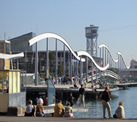|
Congress Themes
Economic activity is inextricably linked to the spatial
distribution and location of economic agents and resources.
Producers, consumers and firms are all spread throughout
space and so the economic value of a commodity can be
measured by its quality, its technology content and
age as well as by its location.
The
relative distances and the costs that the economic agents
have to face in order to make business, produce or obtain
intermediate inputs play a fundamental role in their
rational decisions. Firms requiring an intensive interaction
with consumers usually tend to locate near the demand
in order to cut their final transportation costs. As
suggested more than a century ago by Alfred Marshall,
industrial agglomerations arise in the presence of thick
markets where firms have easier access to productive
factors and where the final output may be sold into
relatively larger markets.
Technological
change, however, has nowadays drastically reduced transport
and communication costs making possible for firms to
decentralize their activities in order to access to
the cheapest labour markets. Crucially, therefore, if
economic distance cannot be purely equated to geographical
distance anymore what is the new balance emerging between
the self reinforcing spatial linkages leading to industrial
agglomerations and the new possibilities of production
decentralization? New challenges are open for those
regions which are now losing their initial “locational
comparative advantages”.
It
is for these fundamental reasons that modern economics
is now incorporating models in which the spatial dimension
is becoming increasingly important. In the past, the
applications of techniques involving the analysis of
space and location were confined to restricted fields
of economics such as regional science or urban and economic
geography. Nowadays, instead, an increasingly wider
of empirical and theoretical investigations is incorporating
spatial analysis and methods. International economics,
labour and public economics, health, agricultural and
environmental economics are only some example of more
traditional fields in economics which are taking advantage
or exploiting the new spatial techniques and methods
of analysis.
Moreover,
it is not only from an empirical point of view that
spatial economics is becoming increasingly important.
A growing methodological literature is nowadays being
used and continuously developed for different kinds
of analysis. Geo-coded dataset are now largely available
and allow the exploitation and development of these
new techniques. Alternative model specification and
testing have been developed in the last years in order
to properly take into account the role played by geography
and by the spatial character of the newly available
data.
Where, why and how production processes, industrial
agglomerations and output markets and all spatially
economic-related activities work and could be analysed
are some of the fundamental questions facing spatial
economics today and that this conference is aiming to
address.
A non-exhaustive list of the empirical themes the SEA
Conference 2009 is going to address is the following:
- Growth
and convergence
- Human
capital
- Inequality
- Knowledge
diffusion
- Agglomeration
of economic activity
- Foreign
direct investment
- Labour
market and migration
- Education
and migration
- Environment
and sustainability
- Externalities,
spillovers and flows
- Land
use, real estate and housing markets
Also,
from a theoretical and methodological point of view:
- Exploratory
spatial data analysis
- Spatial
regression models
- GMM
estimators for spatial models
- Spatial
panel data models
- Continuous-time
spatial econometrics
- Space-time
aggregation
- Spatial
filtering
|















